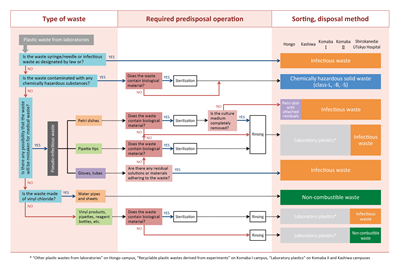Other waste
1. Laboratory plastic waste
Follow the flowchart below for the disposal of plastic wastes from laboratory in UTokyo. First check whether the waste falls into “infectious waste”, and if it does so, follow the rule for infectious waste. If the waste is not infectious waste, next check if it contains chemically hazardous substances. If yes, follow the rule for chemically hazardous waste and request disposal to ESC. Note that syringes must be handled as infectious waste in any situation and biological waste must be inactivated/sterilized before disposal. If the waste does not falls under either infectious waste or chemically hazardous waste, it can be disposed of as “laboratory plastic waste” (the naming is slightly different by campuses). There is, however, no such category in UTokyo Hospital and on Shirokanedai campus, where all the laboratory plastic wastes except for reagent bottles must be handled as infectious waste.

Flowchart of disposal of plastic waste from laboratories at UTokyo
(PDF: internal access only)
Following the conditions above, laboratory plastic wastes such as tips, tubes or gloves that have no attached residuals or remaining liquids are discharged as “other plastic waste from laboratories” in transparent plastic bags so that the contents can be checked easily. When doing this, one must follow the separation rules, being especially careful not to mix plastic wastes from daily living activities. When disposing plastic bottles such as reagent bottles, rinse the inside (collect the rinsing water up to the 3rd times and treat it as chemically hazardous waste) and dispose of after removing labels or write “Washed” clearly on the bottle. Petri dishes should be discharged as “other plastic waste from laboratories” after autoclaving for sterilization, removing culture media and rinsing with water. They must be separated in a different bag from other plastic wastes so that the contents can be easily checked for cleanliness. Petri dishes with culture media attached that cannot be removed should be treated as infectious waste, except for Hongo Campus where the petri dishes are autoclaved in a specially designated bag and discharged into “Petri dish with attached residuals” cart.
2. Laboratory glass waste
Laboratory glass wastes must first be washed well to remove hazardous chemical substances (collect the rinsing water up to the 3rd times and treat it as chemically hazardous waste). If attached residuals are difficult to remove, the waste should be discharged as chemically hazardous waste. For well-washed glass reagent bottles, remove labels and write “Washed” clearly on the bottle to indicate it was washed, put it in a transparent plastic bag and discharge into the container box for glass bottles.
Washed hard glassware from laboratories (such as beakers or test tubes without chemically hazardous substances attached) or pieces of broken experimental glass instruments should be discharged to the cart for incombustible wastes. Pieces of broken glasses are dangerous during collection, so they should be put in a transparent plastic bag and then packed in a box, with “broken glass” clearly written on the box.
3. Large-size waste from laboratory
When disposing of large-size waste items from laboratories, it is necessary to confirm that chemically hazardous substances are not included in the waste. For example, chemically hazardous substances used in experiments, oil, CFCs or asbestos (dispersive/non-dispersive) are sometimes remained on or inside the item. Any oil contained in or attached to the item should be completely removed before disposal. Solid wastes or liquids generated during the cleaning process should be properly disposed of as laboratory waste. Beware of the possibility that oil taken out fromold laboratory equipmentmay contain PCB. If the itemcontains CFCs, recovery and destruction of the CFCs must be conducted by a professional operator; the environment and safety administration official at the division can provide contact information for such a professional. Likewise, for waste items containing asbestos, care must be taken not to allow the asbestos to disperse, and disposal should be contracted to a professional who is able to properly dispose of asbestos via the environment and safety administration official at the division.